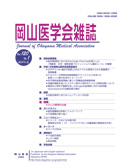

Journal of Okayama Medical Association
Published by Okayama Medical Association<Availability>
Full-text articles are available 3 years after publication.
Permalink : http://escholarship.lib.okayama-u.ac.jp/14210
The effect of nutritional intake on energy metabolism in postoperative patients after gastrointestinal surgery
Yoshizane, Ken
Published Date
1992-10
Abstract
Many studies have shown that enteral nutrition (EN) has nutritional effects comparable to total parenteral nutrition (TPN). However, the energy metabolism of the two different nutritioanl methods remains undefined. The two nutritional methods were compared by measuring the resting energy expenditure (REE) and nutritional assessment in postoperative patients after gastrointestinal surgery. The effects of different amounts of EN were also evaluated. Patients were diveded into three groups : Patients who were fed by EN of 30 Cal/kg/day (Group I, EN 30 : n=8), patients who were fed by EN of 40 Cal/kg/day (Group II, EN 40 : n=8), and patients who were fed by TPN of 30 Cal/kg/day (Group III, TPN : n=8). REE was measured by the Datex indirect calorimetry and nutritional assessment included the measurements of triceps skinfold thickness (TSF), arm muscle circumference (AMC), albumin and rapid turnover proteins. %REE/BEE of EN30, EN40 and TPN was 122.5±14.3%, 138.2±16.8% and 107.6±10.5% respectively. The RQ for the three groups was about 1.0, which means the energy source of all regimens is carbohydrate. The TPN group showed a significantly higher RQ than the EN groups, but there was no difference in albumin or transferrin. There was no difference in nutritional effect between EN 30 and EN 40. No difference was found in anthropometric effects among the three groups. These findings suggest that 30 Cal/kg/day would be preferable to 40 Cal/kg/day in energy supply of enteral nutrition and that the energy expenditure of EN is higher than that of TPN under 30 Cal/kg/day nutrition. There is no difference among the three mehtods in terms of nutritional effects.
Keywords
間接熱量計
経腸栄養
経静脈栄養
代謝熱量
Note
原著
ISSN
0030-1558
NCID
AN00032489
